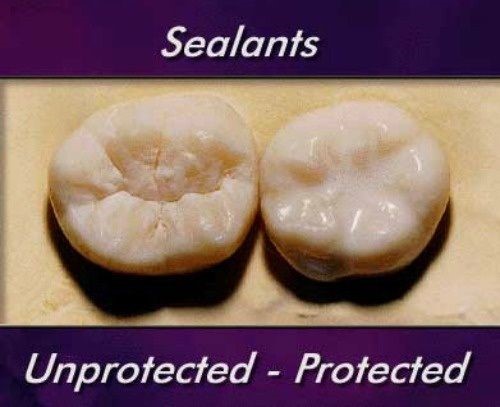Sealants
What are Dental Sealants?
Dental sealants are a thin composite coating that are applied to the grooves on the chewing surfaces of the back teeth to protect them from tooth decay. Most tooth decay in children and teens occurs on these surfaces. Sealants protect the chewing surfaces from tooth decay by keeping germs and food particles out of these grooves. At the office of Brent J. Porter, D.D.S., your Santa Cruz Children's Dentist, we deeply believe in the benefits of this preventative measure!
Which teeth are suitable for sealants?
Permanent molars are the most likely to benefit from sealants. The first molars usually come into the mouth when a child is about 6 years old. Second molars appear at about age 12. It is best if the sealant is applied soon after the teeth have erupted, before they have a chance to decay.
How are sealants applied?
Applying sealants does not require drilling or removing tooth structure. The process is short and easy. After the tooth is cleaned, a special gel is placed on the chewing surface for a few seconds. The tooth is then washed off and dried. Then, the sealant is placed on the tooth. The dentist may shine a light on the tooth to help harden the sealant.
Are sealants visible?
Sealants can only be seen up close. Sealants are usually tooth colored and usually are not seen when a child talks or smiles.
Will sealants make teeth feel different?
As with anything new that is placed in the mouth, a child may feel the sealant with the tongue. Sealants are very thin and only fill the pits and grooves of molar teeth.
How long will sealants last?
A sealant can last for as long as 5 to 10 years. Sealants should be checked at your regular dental appointment and can be reapplied if they are no longer in place.
Will sealants replace fluoride for cavity protection?
No. Fluorides, such as those used in toothpaste, mouth rinse, and community water supplies also help to prevent decay, but in a different way. Sealants keep germs and food particles out of the grooves by covering them with this safe coating. Sealants and fluorides work together to prevent tooth decay.
How do sealants fit into a preventive dentistry program?
Sealants are one part of a child's and teen total preventive dental care. A complete preventive dental program also includes fluoride, twice-daily brushing, flossing, wise food choices, and regular dental check-ups.
Why is sealing a tooth better than waiting for decay and filling the cavity?
Decay damages teeth permanently whereas sealants, protect them. This saves time, money, and the discomfort sometimes associated with dental fillings.

For more information please contact the office of Brent J. Porter D.D.S., Santa Cruz Children's Dentist (831) 459-9802.



